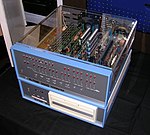Altair 8800 is the one that I was thinking of as the first personal computer.
Here's Wikipedia on the history of personal computers. HP is nowhere to be seen there.
en.wikipedia.org
Altair 8800[ edit]
Main article: Altair 8800

1975: Altair 8800
Development of the single-chip microprocessor was the gateway to the popularization of cheap, easy to use, and truly personal computers. It was only a matter of time before one such design was able to hit a sweet spot in terms of pricing and performance, and that machine is generally considered to be the Altair 8800, from MITS, a small company that produced electronics kits for hobbyists.
The Altair was introduced in a Popular Electronics magazine article in the January 1975 issue. In keeping with MITS's earlier projects, the Altair was sold in kit form, although a relatively complex one consisting of four circuit boards and many parts. Priced at only $400, the Altair tapped into pent-up demand and surprised its creators when it generated thousands of orders in the first month. Unable to keep up with demand, MITS sold the design after about 10,000 kits had shipped.
The introduction of the Altair spawned an entire industry based on the basic layout and internal design. New companies like Cromemco started up to supply add-on kits, while Microsoft was founded to supply a BASIC interpreter for the systems. Soon after, a number of complete "clone" designs, typified by the IMSAI 8080, appeared on the market. This led to a wide variety of systems based on the S-100 bus introduced with the Altair, machines of generally improved performance, quality and ease-of-use.
The Altair, and early clones, were relatively difficult to use. The machines contained no operating system in ROM, so starting it up required a machine language program to be entered by hand via front-panel switches, one location at a time. The program was typically a small driver for an attached cassette tape reader, which would then be used to read in another "real" program. Later systems added bootstrapping code to improve this process, and the machines became almost universally associated with the CP/M operating system, loaded from floppy disk.
The Altair created a new industry of microcomputers and computer kits, with many others following, such as a wave of small business computers in the late 1970s based on the Intel 8080, Zilog Z80 and Intel 8085 microprocessor chips. Most ran the CP/M-80 operating system developed by Gary Kildall at Digital Research. CP/M-80 was the first popular microcomputer operating system to be used by many different hardware vendors, and many software packages were written for it, such as WordStar and dBase II.
Homebrew Computer Club[ edit]
Main article: Homebrew Computer Club
Although the Altair spawned an entire business, another side effect it had was to demonstrate that the microprocessor had so reduced the cost and complexity of building a microcomputer that anyone with an interest could build their own. Many such hobbyists met and traded notes at the meetings of the Homebrew Computer Club (HCC) in Silicon Valley. Although the HCC was relatively short-lived, its influence on the development of the modern PC was enormous.
Members of the group complained that microcomputers would never become commonplace if they still had to be built up, from parts like the original Altair, or even in terms of assembling the various add-ons that turned the machine into a useful system. What they felt was needed was an all-in-one system. Out of this desire came the Sol-20 computer, which placed an entire S-100 system – QWERTY keyboard, CPU, display card, memory and ports – into an attractive single box. The systems were packaged with a cassette tape interface for storage and a 12" monochrome monitor. Complete with a copy of BASIC, the system sold for US$2,100. About 10,000 Sol-20 systems were sold.
Although the Sol-20 was the first all-in-one system that we would recognize today, the basic concept was already rippling through other members of the group, and interested external companies.
Other machines of the era[ edit]Other 1977 machines that were important within the hobbyist community at the time included the Exidy Sorcerer, the NorthStar Horizon, the Cromemco Z-2, and the Heathkit H8.
1977 and the emergence of the "Trinity"[ edit]

The three computers Byte magazine referred to as the "1977 Trinity." From left to right: The Commodore PET 2001, the Apple II, and the TRS-80 Model 1.
By 1976, there were several firms racing to introduce the first truly successful commercial personal computers. Three machines, the Apple II, PET 2001 and TRS-80 were all released in 1977, [39] becoming the most popular by late 1978. [40] Byte magazine later referred to them as the "1977 Trinity". [41] Also in 1977, Sord Computer Corporation released the Sord M200 Smart Home Computer in Japan. [42] |






